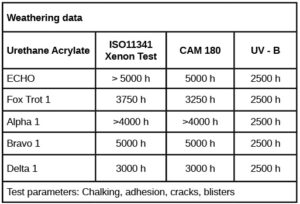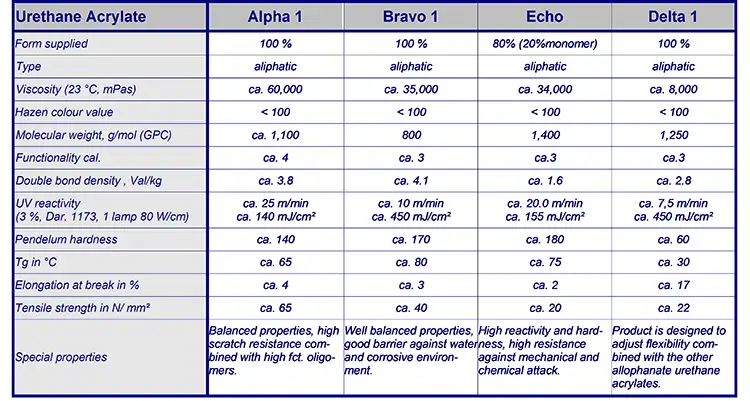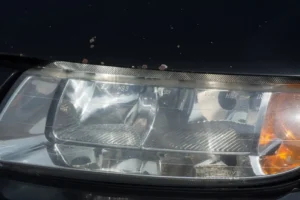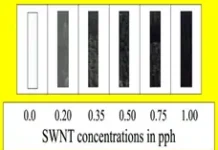By Michael J. Dvorchak, Dvorchak Enterprises, LLC
The automotive industry over the last several decades has pushed the technology for automotive forward headlighting from glass to polycarbonate plastics (PC). Although there are obvious advantages to polycarbonate, such as weight reduction and improved safety, there also are issues with deterioration over time of the ultraviolet (UV) -cured protective hard coatings used to protect the polycarbonate plastic from impact abrasion, moisture and sunlight.
Today, there are an estimated 278 million registered vehicles and 556 million PC UV hard-coated headlights in service in the United States. Americans are hanging onto their cars, minivans and SUVs, helping to push the average age of the nation’s light-vehicle population to a record high of 12.2 years in April of 2023. At the same time, the nation’s aging car and light-truck population is creating pent-up demand that is spurring US new-vehicle sales to record highs, with projections that the total number of cars and light trucks in operation in the US will grow to 318 million by 2028. With this substantial number of older vehicles in service and the number of vehicles older than 12 years surging by more than 20 percent over the past five years, just a small percentage of deteriorated PC headlights is a large potential refinish market. 1
Attempts to resolve the issue of deteriorated PC UV hard coats have seen the introduction of everything from toothpaste to Original Equipment Manufacturer (OEM) -style UV-A refinishing hard coats. This paper will review this developing UV-cure coatings market and present a solution based on the use of a UV-A-cured hard coat repair for polycarbonate headlight lenses.
Introduction
Automotive headlight UV hard coats have deteriorated due to sunlight, moisture, carwashes, dirt and many other environmental conditions. Over the last several years, several after-market suppliers to the automotive industry have developed a refinishing technique to replace deteriorated UV hard coats on PC auto headlights, generating a proliferation of innovative ideas and products. The key will be identifying products that just do not offer a cover up to the issues but offer true performance to the vehicle owner.
Consumer Reports has done a study on current products in the market and has reported,
“The yellow and fogginess you see on car headlights as they age will affect how much light is projected out onto the road and degrades your visibility,” says Jennifer Stockburger, director of operations at Consumer Reports’ Auto Test Center. “There’s a polycarbonate coating that goes on headlight lenses, and that’s what’s deteriorating as your headlights age, particularly in areas where cars get a lot of sun.”
In addition, Consumer Reports also reported,
Either do-it-yourself or do-it-for-me, the kits are not a permanent solution. The hazing effect will return, typically becoming noticeable after a year based on our tests, says Jennifer Stockburger. 2
A concern here is that Consumer Reports is saying that the coating is based on polycarbonate coating. The reality is that the coating used to protect the polycarbonate headlight is based on a UV-cure polyurethane coating hard coat. It also is noteworthy that the products that Consumer Reports evaluated only lasted
one year.
Current Products in the Market

Attempts to resolve the issue of deteriorated PC UV hard coats (Photo 1) have seen the introduction of everything from toothpaste to OEM style UV-A refinishing hard coats. The PC headlight on the vehicle in the photo has deteriorated to a level where driving with such low-performing headlights is dangerous to the vehicle owner. The candela survey done on these headlights showed that the light output on low beam was 3,000 Candela and 7,000 Candela on high beam (The legal limit for low beam is 55,000 candela and 150,000 Candela for high beam.). The test was performed on untouched head lamps using a Hoppy Vision 100 Light Reader.
A recent study by AAA states that the coating on the PC headlight unit is, in some cases, only giving off 20% of the original Candela from when the car was first purchased. 3 This is an obvious condition that the vehicle owner should remedy immediately.

A multitude of products have been introduced to the market to try and resolve this issue. Several types 4 use a sanding operation and polishing to rejuvenate the deteriorated head lamp. Another promotes the removal of the deteriorated hard coat and then a sealant that will protect the PC for two years. 5 In all, about 20 solution offerings were found. About half of the techniques surveyed by the author used a sanding and polishing technique, while the other half used some type of sealant or protectant after removal of the UV hard coat. These kits tout performance, but none of them have the quality or performance to give the proper amount of lighting performance needed in today’s extreme environment. Table 1 provides an updated list of products that are touting the performance of headlight restoration kits. 6
The professional technique for refinishing shows the use of a solvent-based acrylic or a traditional 2K polyurethane that is used by auto refinishing technicians. One of the products surveyed found a 2K PUR 7 that has such performance. The development of a UV-cure PC refinishing system first was revealed at a conference in February 2005, 8 introducing the concept of an OEM style UV-A refinish hard coat. That patent, 9 filed on March 18, 2004, as well as another patent filed on June 20, 2005, review the removal of the deteriorated hard coat and application of a sealer or coating. 10
The repair of the PC, whether it is polishing or coating, elevates the performance of the headlight output. Replacement costs for the headlight assembly are extremely high. The ability to refinish the headlight is a distinct advantage for the vehicle owner.
OEM-Style UV-A Refinish Hard Coats

When searching for a technology to replace the deteriorated OEM hard coat through refinishing techniques, it is important to use a similar technology. Researchers went to the traditional formulations, as described in a conference paper. 11 In this paper, it was shown that the traditional polyisocyanurate chemistry in the OEM environment would perform and has performed to meet the stringent OEM performance requirements. As can be seen in Table 2, the formulation is designed to be used on PC substrates that already are protected by UV absorbers and HALS-amines. In addition, the UV cure polyurethane hard coat also is protected by UV absorbers and HALS-amines. Weathering studies have shown that the aliphatic urethane acrylate nicknamed ‘Echo’ (Table 3) performs extremely well in accelerated weathering. Product Echo has gone greater than 5,000 hours in the accelerated weathering studies, such as Xenon arch using ISO 11341 testing parameters. So, for the PC refinisher, it is evident that by using this base oligomer (Echo) the expectations are that the system will perform better than any other type or style of product in the PC auto headlight refinishing marketplace.

Taking a page out of the performance aspect of these OEM PC UV hard coats, formulations were developed to mimic the style and performance of the OEM hard coat. The old UV hard coat was removed by wet sanding at different grit levels until virgin PC is obtained. Once this is completed, the OEM-style product is spray applied, flashed and UV cured with a UV-A-style light source.
The resulting headlight unit will show an increase as described previously from a 3,000 Candela for low beam to a 7,000 Candela (a difference of 4,000 Candela) after the OEM-style refinish UV-A hard coat was applied. This is an increase of 57% Candela. In addition, the high beam after refinishing jumped to 17,000 Candela (a difference of 10,000 Candela) This is an increase of 59% Candela.
Advanced Oligomer Technology for the PC Head Lamp Refinishing Market
As was shown in the earlier discussion, the traditional polyisocyanurate-based oligomer (Echo) performs well in accelerated weathering studies. One drawback to this style of chemistry is the acrylate monomer used in this formulation. This monomer in a closed OEM contained environment has been used quite successfully. However, in a refinish environment, the spray atomization of the monomer would be of concern. Researchers realized this and needed to develop a new style of chemistry, termed an allophanate. 11 The uniqueness of this allophanate chemistry is the ability to ‘tailor-make’ the molecule so that the hydrogen bonding is placed in the so-called ‘sweet spot’ of the chemistry. What is meant by this is that traditional polyisocyanurate oligomers have a significant level of hydrogen bonding. Thus, the resultant viscosity of the oligomer is too high and needs to be cut in acrylate monomer to obtain a ‘use viscosity.’ With the development of the allophanate oligomers, the reduced hydrogen bonding helped dramatically reduce the ‘use viscosity.’

This use viscosity is quite evident by comparing base viscosities of Echo (isocyanaurate oligomer) to Bravo 1 (allophanate-based oligomer), as shown in Table 4. Where Echo has a RT viscosity of 34,000 mPa s, Bravo 1 comes in at 35,000 mPa s. To get Echo down to the same level of viscosity, the addition of 20% monomer is needed to meet the same viscosity as the allophanate oligomer. For the development of newer PC auto headlight UV-A coatings, it would make more sense to use the Bravo 1 technology so that the use of the any monomer is eliminated due to industrial hygiene concerns.

The longevity of the OEM-style UV-A-cured refinish hard coat is another question that looms in the minds of the critics of this technique. In Photo 2, the use of Alpha 1 (allophanate) shows the lack of deterioration over three years of use in the Northeastern part of the US. Planned work to use Bravo 1 (allophanate) as described previously will allow better ‘use viscosities.’ This performance proves that the use of an OEM-style UV-A refinish hard coat has performance attributes beyond other products in the market. It also is obvious from this photo that under this severe environment, as shown by the stone chips above the headlight, that the integrity of the hard coat was not violated by this severe environment.
UV-A Cure Sources

When jumping into the realm of site-applied UV curing systems, worker safety is important. In the auto and aerospace markets, UV equipment suppliers responded with the development of a UV-A source specifically designed with PC UV-A refinishing in mind. As is shown in Photo 3, the UV-A source is mounted on a unique stand, allowing the auto technician flexibility in performing the refinishing of the PC headlamp. An additional safety aspect of this lamp is the use of safety shutters that can be used when the lamp is warming up so as not to expose the refinishing technician to UV-A emittance.

A recent paper published showed the innovation in small-damage repair using an LED UV-A cure unit (Photo 4) in the form of IST INTECH America’s AC-500 battery-powered portable UV LED handset. 12 This unit’s unique features are that it operates as a UV-A LED at the following wavelengths: 365 nm, 395 nm or 405 nm. It’s cure footprint is 90 mm by 200 mm, and the unit has a 26-minute battery life. This technology innovation hits the sweet spot for PC headlight repair in the automotive refinishes industry. 13
Conclusions
With over 556 million PC headlights in service and with the average age of US vehicles on the road today at 12 years, the need for an OEM-style UV-A-cured refinish hard coat system has become very apparent. Consumer Reports and AAA also have found that the deteriorated UV hard coat on the PC headlight is a serious safety issue. With tests reporting that some of these headlights are only emitting 20% of the original performance, it is obvious that this major safety concern needs to be addressed.
Since the inception of the use of a UV-cured hard coat to protect PC headlamps, the question about longevity has been an open question. It is obvious that not all UV hard coats exhibit the same performance. The development of an OEM-style UV-A-cured refinish hard coat hopes to resolve this important safety issue, and the allophanate chemistry is the most sustainable as it does not require the use of additional monomers and offering an ultra-low VOC/VHAP coating formulation.
Coatings industry organizations should petition state and federal Departments of Transportation to view the UV-A-cured refinish hard coat system as a safe and economically viable technique to solve this serious safety problem.
References
- Car Ownership Statistics 2024, Forbes Advisor, https://www.forbes.com/advisor/car-insurance/car-ownership-statistics/#department-of-transportation-federal
- Pratt, D., Do Car Headlight Restoration Kits Really Work? Consumer Reports, July 15, 2023
- Olsen, P; Old Headlights Can Be Dangerously Dim, Study Finds, Consumer Reports, Dec. 11, 2018
- 3M 39008 Headlight Lens Restoration; http://3mauto.com/products/headlight-restoration
- Philips HRK00XH Headlight Restoration kit; http://www.p4c.philips.com/cgi-bin/cpindex.pl?ctn=HRK00XM&hlt=Link
- Kiefer, James; Best Headlight Restoration Kits; Motor1.com, January 3, 2024
- The Illuminator; Cumberlandproductsinc.com; introduced at the SEMA show in 2011.
- Subramanian, R; UV Refinish for Plastic Headlamps, UV EB West 2005
- US 7,404,988; Headlight Lens Resurfacing Apparatus and Method; Terry, Mitchell Kunta
- US 7,163,446; Vehicle Headlight Restoration; Cole et al.
- Dvorchak, M. J., Henderson, K.A., Gambino, C.A., Acrylated Allophanate oligomers that are 100% solids with low viscosity and high functionality, RADTECH NA Conference, May 2010
- Dvorchak, M. J., UV Cure Automotive Refinish, Clearcoats and Primers at The Speed of Photons, CoatingsTECH NOV/DEC 2022, pp 18-29
- Integration Technology UV-A LED Battery powered portable handset for small automotive refinish repair, https://www.integrationtechnology.com/en/products/portable-uv-curing







